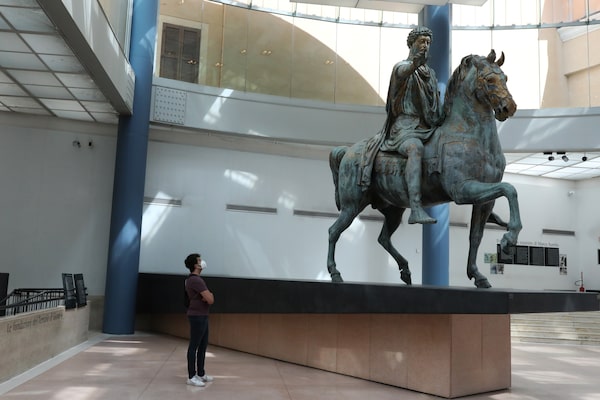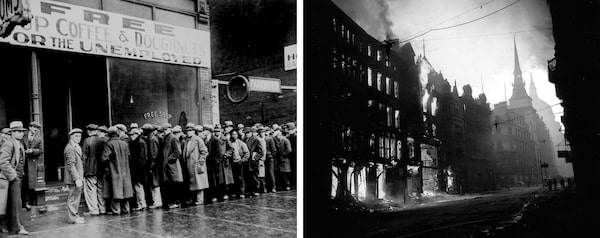
PHOTO ILLUSTRATION: THE GLOBE AND MAIL (SOURCE IMAGE: ISTOCKPHOTO)/PHOTO ILLUSTRATION : THE GLOBE AND MAIL. SOURCE IMAGE: ISTOCK PHOTO
David Berry’s first book, On Nostalgia, was published this week. He lives in Edmonton.
The disease’s main symptom was a rash, rampaging across and through the body, blistering and bloodying any surface it infected, including internal ones. If you were lucky, after two weeks of fever, violent stomach pains and bloody diarrhea, the scabs would blacken and heal over, letting you walk away with permanent, perhaps debilitating scars. If you weren’t, you would cough or defecate so violently you would peel your own internal scabs, leaving you in a stuporous agony that took its time finishing the job.
The plague that ebbed and flowed through the Roman empire from about 165 to 180 CE – it was probably Rome’s first brush with smallpox, although the diagnosis is not definitive – was brutal to individuals, and not much better to their society. Rome lost five to seven million of its citizens, a third to a half of the population in some areas. Contemporary accounts claimed that, at its peak, 2,000 people died every day; historical investigations have suggested that number might be more like 5,000. The disease likely killed two successive emperors, including Marcus Aurelius Antoninus, who got the plague named after him. Rome’s weakened armies allowed barbarians across its outer frontiers; fields spoiled or went fallow for lack of anyone to farm them. Most historians see the first wobbly steps of Rome’s decline in this cascading cataclysm.
Somewhere among the piles of pestilent bodies, though, people have found something to look back on adoringly. Edward Gibbon, the 18th century historian, opens his six-volume opus The History of the Decline and Fall of the Roman Empire by praising the era that includes the plague-ridden reign of Marcus Aurelius; he called it “the period in the history of the world during which the condition of the human race was most happy and prosperous.” If you are thinking that a millennium-and-a-half of distance might have clouded his judgment some, Gibbon was only following his primary sources: Cassius Dio, a senator and historian who lived through the plague – he’s one of the sources of the 2,000-dead-a-day figure – specifically refers to the empire under Marcus Aurelius as a “Kingdom of Gold.” He pointed to reforms that included allowing the sons of slaves to hold office (because too many of the aristocrats who had been holding them died) and allowing immigrants to settle in the empire (for basically the same reason) as examples of this greatness. It was only after people stopped dying en masse, according to Cassius, that Rome descended into “iron and rust.”

Francesco Pantaleo, 30, wears a mask as he looks up at the equestrian statue of Marcus Aurelius at Rome's Capitoline Museums this past May, when he was the first visitor to enter since the museum reopened from lockdown.Marco Di Lauro/Getty Images/Getty Images
If the periodic occurrence of abject misery is a law of nature, something as inevitable as the decline and fall of the glorious and mighty, then nostalgia is its equally irresistible corollary. In the midst of our own plague, nostalgia has had a marked resurgence. This has, naturally, tended to focus on the pre-COVID-19 era: nostalgia is considered and indulged right now as medicine for the mind, a comfort that helps us deal with a frighteningly unknowable world, filled with death and deprivation. (More than usual, I mean.) Right now, it makes sense that we turn to Mom’s mac and cheese, or binge-watching our favourite TV series, or even just the memory of hugging a friend for a bit of normalcy to keep us keeping on.
But nostalgia is far weirder than mere comfort food.
As hard as it may seem to believe at the moment, while thousands are still dying and thousands more treat the prospect of getting a haircut as a minor miracle, we will one day look back on these times and wish we had them back. Not the quarantined care homes, of course, or the hands raw from washing, or the buzzing paranoia of shuffling past someone on the sidewalk, but some small part of it, some simple shred of decency that will slowly grow to stand in for the whole, or at least enough of it that we don’t spend too much time thinking about how worried we were that a trip to the grocery store was going to kill our grandmother.
If there are any optimists left behind the face masks, these impending rose-coloured glasses could look a bit like a stirring triumph of the human spirit: Look what humanity can go through, they say, pausing briefly to cough into the crook of their elbow, and still come out not just okay but so positively resolute that we can celebrate our triumphs through adversity!
As in most cases, though, these optimists have missed the point. They are not stupid, exactly, just incurious, or anyway altogether unwilling to accept that humans are not governed by choice and resolution so much as blind luck and dumb reflex, retroactively justified. Our nostalgia, like most of our instincts, is absurd and broken – but just absurd and broken enough to thrive in a fickle, uncaring world, which can be shut down indefinitely by a feverish bat.
Nostalgia is inevitable because our minds are made to be operating software, not storage devices; they are built to keep us moving, a constant churning that turns them into something like nostalgia machines. We have now lived through just about enough of These Unprecedented Times to begin to appreciate how the relentlessness of living inevitably sands and shapes our memory not into a perfect record, but a perfect platform upon which to live the rest of our life. We have also not yet lived through enough of them that we still can’t see the shavings on the floor.

A masked woman passes a boarded-up storefront on Robson Street in Vancouver this past May, when British Columbians were still under lockdown to stay safe from COVID-19.Darryl Dyck/The Canadian Press/The Canadian Press
Unquestionably the two things I have spent the most time doing since the lockdown began have been keeping my two-year-old daughter alive and trying to reach the end of my social-media feed. Any guess as to which one has actually produced identifiable memories I can point to? Though I have the screen-time stats to prove my flicking finger is the only part of my body getting anywhere near the recommended amount of daily exercise, the endless numbered threads I have read sit together like a formless glob, a drain clog of downtime detritus, congealed into identifiable impossibility. And yet I can tell you almost down to the hour when I converted into a playhouse one of the boxes our couch came in (March 23, 10 a.m.-ish) – and which days I drew a crude Cookie Monster (March 31), she added address label stickers (April 22) and she grew bored of it and effectively stopped playing with it entirely, except to occasionally peel off the address labels and stick them to her forehead (May 7).
There are things that seem like mitigating factors here, of course: social media is partly designed to turn time into a featureless white void with no beginning or end; I have enough pictures of my daughter to stop-motion-animate her quarantine, never mind reference her milestones. But this gulf is part of the point: I want to and do revisit the good times I have had with my daughter, and bury most of my other mediocre-to-miserable experiences under a mass of mindless scrolling (or depressive lethargy, or distractive cooking, or aimless, physically distanced wandering). As I return repeatedly to these fleeting bits of comfort, they not only are contoured by my need for them to be comforting – of course we were having fun together, not just desperately trying to fill the minutes before she could nap and I could resume my online catatonia – but they crowd out the shapeless and shunted memories I don’t care to think about. Just four months later, I have already forgotten the weight of the terror and exhaustion I felt in the first week of the lockdown, when my family went into hard quarantine while we all traded flu-like symptoms (probably just a seasonal thing my daughter picked up when daycares were still open, although who knows, you couldn’t get a test with our particulars then, and … well, anyway, I don’t like to think about it).
You can see how this process, repeated until death, could lead me to consider this time surprisingly tender or even heartwarming, maybe even a period during which “men, women and children … loved more strongly, felt more deeply, generated more warmth and had more compassion for our fellow men than ever in our history, before or since.” That, for the record, is how one American described The Great Depression, one of the few eras with a name that, you’d think, also accurately captured the general mood of the populace.
But still, even this incidentally selective editing of memory is only the mechanism of nostalgia. Not until the ripples of the pandemic have crested and subsided will we create the historical narrative around it – the story we will tell ourselves about this time and what it means.

The go-to metaphors for adversity on both sides of the Atlantic: The Great Depression in the United States, as illustrated at left by a Chicago soup kitchen in 1931, and the Blitz in Britain, shown at right as shops burn in London's Ludgate Hill neighbourhood in 1941.Archival photos, The Associated Press/Archival photos, The Associated Press
You can see glimpses of this in our misty-eyed survivor of the Depression. The deprivations of America’s Dirty Thirties made way for the New Deal, a seemingly explicit attempt to transform the abundant warmth and compassion of the country’s men, women and children into action. But then maybe the people only start to seem more compassionate because the New Deal was one of its effects: this era also produced The Hobo Code, which, when it wasn’t warning the indigent about the people who were going to hurt them, was telling them how to exploit the easy marks. The story we begin to tell ourselves will have as much of an effect on what we remember as what we actually remember.
Nostalgia’s purest purpose, after all, is to reconcile ourselves with our past. It helps us form a meaningful identity from the morass of accidents, lingering feelings and half-realized, quarter-remembered ideas about what actually happened. As we strive for the sense of identity that will help us make sense of COVID-19, how we survived it will morph to fit the narrative, our past experience will shift to serve our current needs.
You could perhaps illustrate this by thinking about which Americans, for instance, are willing to call back to the spirit of the New Deal right now – that is to say, which ones think compassion and fellow-feeling are a necessary part of the American identity at the moment. But a better example might be one that isn’t in dispute: London’s vaunted Blitz spirit, Britain’s go-to example of the character of its people, and nation, since the Second World War.
From the ubiquitous stiff-upper-lipped-ness of the Keep Calm and Carry On posters – posters that were never even mass-displayed during the Blitz, speaking of mixed-up memories – to woolly Brexiters promising that self-inflicted head wound would spark the same resolve as being bombed by Nazis, there are few scenarios where some Briton won’t evoke the can-do attitude of people whose nights and days alternated between hiding in Tube stations and sifting through rubble. (Right on down to recurrent Blitz-themed parties, although these apparently have been cancelled owing to the current crisis.)
It should hopefully go without saying that being bombed isn’t quite as much fun as getting bombed in period-appropriate costumes; more to the point, though, the vaunted solidarity that supposedly emerged was far more a comfortable fiction of the upper classes than a universal experience on the ground. Looting and profiteering were not common, but happened regularly. Anti-Semitism grew. Most notably, though, the working-class Londoners who lived near the factories most bombs were aimed at viewed themselves as cannon fodder who were expected to take it while the wealthy and powerful hid out in their country estates. Strikes and outrage at the government’s “carry on”-style messaging were common: Plenty of historians attribute the seething resentment and decided lack of solidarity felt by these workers with the landslide victory of Labour in the 1945 election and the subsequent building out of the welfare state.
If you ignore the angry roots, the rise of the welfare state fits the narrative of a country coming together through strife. More importantly, though, as a metaphor for modern Britain, Blitzed London could not be touched. Free of both imperial baggage and any connection to the continent, it was a shining example of Britain standing on her own, an island against the world. And so the small stories of solidarity and triumph took on outsized importance; a poster that most people never saw, and would have outraged half the city had they seen it, becomes ubiquitous kitsch.
A 'keep calm and carry on' sign sits in the window of a closed London thrift store a day before all shops were allowed to reopen in June.Kevin Coombs/Reuters/Reuters
We do not know exactly what lingering effects COVID-19 will have on us, individually or collectively, but we can say with some confidence that it will profoundly shape us. Maybe it will be more bike lanes and better elder care; maybe it will be more anti-vaxxers and the collapse of the United States. Whatever happens, though, These Times will be formative, will give us a base for understanding who and what we have become since they happened. This sense of identity will surely be blinkered and convenient and only as true as we need it to be, but so are all of them; the point is that it will need a place to root – preferably one already cultivated with good memories, clinging to the soil out of desire as much as desperation.
Assuming this isn’t an extinction-level event, in some distant time, maybe even just another generation or two, no one will believe that there was much of this time worth living through. That’s probably an equally blinkered view: the Romans of the second century, no less than the Americans or Britons of the mid-20th, or Canadians of the early 21st, ate and drank and taught their children and held their lovers and made art and learned to bake and whatever other busy activities make up a life in these times. It is all we really can do. And if we will pluck the shiniest gem from two months – or two years, or god knows how long this lasts – and let its gleam wash out the tedium and terror of the era, we will do so for the same reason: It’s all we really can do. Whatever else it is, this time is all we have. What other past are we going to yearn for?

Zinkevych/PHOTO ILLUSTRATION: THE GLOBE AND MAIL (SOURCE IMAGE: ISTOCKPHOTO)
Keep your Opinions sharp and informed. Get the Opinion newsletter. Sign up today.